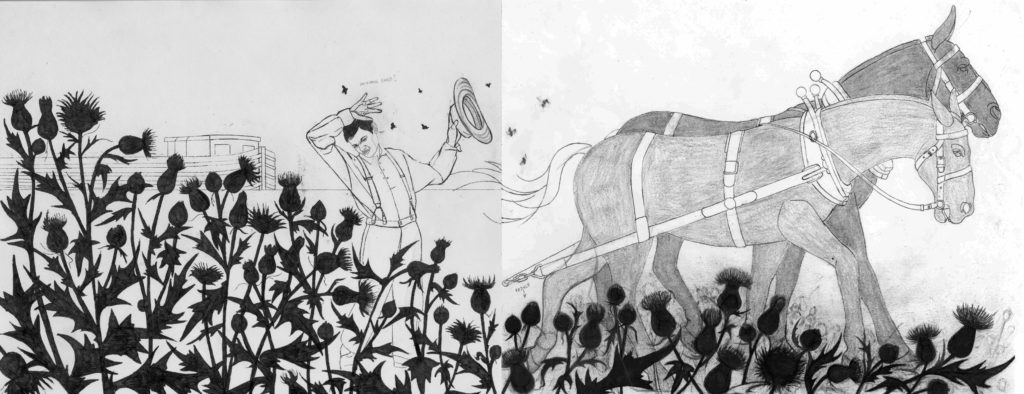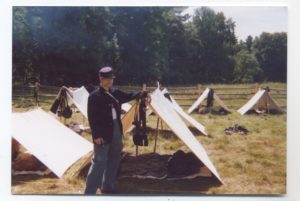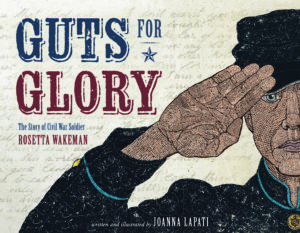“An Extreme Measure for Extreme Research”
I blame my new picture book biography of Rosetta “Lyons” Wakeman for sparking my imagination and setting me off into a near quarter-century whirlwind of books, paper, and miniature toy soldiers—all in the name of research. But sometimes you have to go to extremes, especially when you’re inspired to write a book about someone as extraordinary as Wakeman, a heroic woman who disguised herself as a man to fight for the Union Army in the Civil War.
Inspired research can take you to unimaginable places physically, mentally, and spiritually.
Research–specifically travel–helped create an emotional core for my writing.
Early in my Guts for Glory research, I planned four separate trips, based on specific dates of Rosetta’s real-life letters, all with the goal of better understanding the local and regional histories of the places she traveled and fought.
A trip to Binghamton, New York, allowed me to explore the Chenango Canal area where Rosetta worked after first leaving home. I collected tourist pamphlets from visitor centers and visited the Erie Canal Village in Rome, New York, where I experienced a canal ride on a packet boat pulled by a pair of mules. I observed the steersman operating the tiller and photographed the tacking of mules, which served helpful when developing sketches. On my second trip to upstate New York, I visited the Erie Canal Museum in Syracuse, where I boarded a life-size replica of a canal boat and explored the interior live-in quarters of a cabin. Then, I went to Delaware, where my measurements were taken for a custom-tailored Union frock coat and forage cap at Grand Illusions Costume Co., a reproduction clothing manufacturer that’s no longer in business. It offered an authentic portrayal of the 153rd Regiment, New York State Volunteers uniform.
Next, I made a brief visit to Alexandria, Virginia, and Washington, D.C., where I photographed the United States Capitol from the Supreme Court, where the Old Capitol Prison once stood. This particular image was helpful for developing the center spread showing where Lyons and her regiment guarded Washington, D.C. Lyons was on duty at the Old Capitol Prison from August to October 1863 (Note: Rosetta Wakeman appears on the Carroll Prison Guard Reports during August, September, and October of 1863).
My last trip was to Louisiana, where I took a luncheon cruise on the steamboat Natchez. Then I followed the Red River Campaign, traveling by car from Algiers, outside of New Orleans, (where Lyons Wakeman is buried) to Shreveport, visiting places of interest along the way like Lafayette, Natchitoches, Alexandria, and important landmarks such as the Mansfield State Historic Site and the Pleasant Hill Battle Field Park. All of this travel helped me to better interpret Rosetta’s experience.
Inspired research can stretch your imagination further than expected.
One could spend a lifetime in study, as many Civil War scholars and buffs do. During my research, I devoured book after book, finding bibliographies treasure troves of information, leading to the discovery of works by nineteenth-century as well as modern-day authors and artists. I read books by writers such as Louisa May Alcott, Harriet Jacobs and Richard Taylor and artists such as Winslow Homer, William Michael Harnett, Fanny Palmer, and Lily Martin Spencer. Each work contributed to my understanding of a bygone era, fueling my imagination. and eagerness.
But what better way to understand a character than to walk in their ill-fitting brogans, which I did as a Civil War re-enactor. I could use my five senses in experiences much like Rosetta’s. I’ve had plenty of black gunpowder grit between my teeth when tearing open blank (ammunition) paper cartridges during living history and mock battle events.
I’ve suffered from blisters on both Achilles heels after light marching, later relegating to wearing plastic bread bags on both my feet to reduce the friction, only to have them gathering at my toes.
I wore my blood-stained wool socks as my Red Badge of Courage until discovering sometime later with much horror, my rescue dog had snacked on them. Gross! I recall stepping and sliding into a manure patch when pitching my army pup tent. Thankfully, I never lost my balance. And during rainy events, my uniform smelled like a barn animal, but during dry events, I favored the lingering trace of campfire smoke left on my uniform.
Whatever you absorb, even if it’s by incredible means, you might end up only including about 10% of it. Leaving out 90% of hard-fought, time-invested research is one of the toughest parts of the writing and/or illustrating process. After all, your character’s emotional core, built through that research, is the true heart of the story.
Inspired research can ultimately carry your interest beyond life’s obstacles (A.K.A. The Struggle) and into something beyond your biggest dreams.
So, what inspired me about Rosetta Wakeman to devote over two decades of study? In hindsight, I was inspired by a young, strong-willed woman, struggling for the privilege to live independently, an unobtainable goal for most women in that time, especially a poor, rural farm girl, who put herself at great risk with her choices.
Writing and illustrating Guts for Glory involved a lot of choices, too, along with sacrifice and continued research of the actual publishing process. I joined the Society of Children’s Book Writers and Illustrators (SCBWI) organization to learn more about the industry. Each year, I remained committed to attending the New England Regional Conferences. I learned how to write a manuscript, create a dummy book, assemble and update an illustrator’s portfolio, create eye catching promotional cards. I received constructive criticism year after year for five years. I even put Guts For Glory aside and began working on a second book until Eerdmans contacted me in 2013. I had forgotten I sent them an unsolicited manuscript! And now the book is here.
I loved living inside a book, filled with creative bliss for 20 years. It was truly inspiring. Reality is much harder. So, what research is your writing inspiring you to do?
Published February 27th, 2024 by Eerdmans Books for Young Readers
About the Book: A dramatically illustrated biography of Private Rosetta “Lyons” Wakeman, the only soldier whose letters capture the Civil War from a woman’s perspective. In 1862, the war between North and South showed no signs of stopping. In rural New York, nineteen-year-old Rosetta Wakeman longed for a life beyond the family farm. One day she made a brave, bold she cut her braid and disguised herself as a man. No one suspected that “Lyons” was a woman—not even when she signed up to fight for the Union. As Rosetta’s new regiment traveled to Virginia, Washington, D.C., and Louisiana, she sent letter after letter home to New York. Army life wasn’t easy, but Rosetta knew it was where she belonged—keeping her family safe and her country free. Through intricately detailed scratchboard art and excerpts from Rosetta’s letters, this fascinating biography introduces young readers to an unconventional woman who was determined to claim her own place in history. Memorable and inspiring, Guts for Glory is a stirring portrait of the Civil War and the courage of those who fought on its front lines.
Book Trailer:
Discussion Guide:
About the Author: JoAnna Lapati is a writer and artist based in Warwick, Rhode Island. While researching this book, she retraced Rosetta’s footsteps by traveling to sites like the Chenango Canal, the US Capitol, and the Mansfield Historic Site Museum and Pleasant Hill Battle Park. JoAnna also spent six years as a Civil War reenactor with the 22nd Massachusetts Volunteers- disguised as a man, just like Rosetta. Guts for Glory is JoAnna’s debut picture book. Visit her website at joannalapati.com.
Thank you, JoAnna, for this look into your research and how research inspires!





